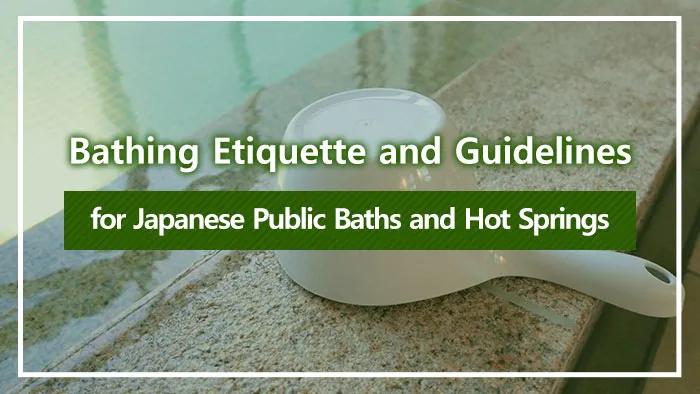Japanese public baths and hot springs are popular destinations for travel and everyday relaxation. However, first-time visitors and those from abroad often feel uncertain about what to bring, what manners to observe, and the correct bathing procedures.
This article provides a clear explanation of the items you’ll need, bathing etiquette, and step-by-step procedures when visiting public baths and hot springs. By understanding the process from preparation through post-bathing, you can confidently enjoy Japan’s traditional bathing culture.
1. Essential Items for Japanese Public Baths and Hot Springs
When using bathing facilities such as public bathhouses, natural hot springs, and super sento in Japan, it’s important to prepare the necessary items in advance. Some hot spring facilities may have limited amenities, so use the following list to ensure you don’t forget anything.
<Essential Items List>
●Cash Including Plenty of Coins
Cash is required to pay the bathing fee. You’ll frequently need coins for lockers, hair dryers, and purchasing drinks, so it’s reassuring to have 10-yen and 100-yen coins ready.
●Change of Clothes Including Underwear and Socks
Bring clothing to change into after bathing. In winter, it’s recommended to prepare warm clothing to prevent catching a chill.
●Face Towel and Bath Towel
Bring a face towel for washing your body and a bath towel for drying off after bathing. Thin towels are convenient as they don’t take up much space in your bag.
●Shampoo, Conditioner, Soap, and Facial Cleanser
Some facilities don’t provide amenities. Bringing your usual products helps avoid skin troubles. Travel-sized bottles or pouches are convenient.
●Makeup Remover and Skincare Products
Don’t forget makeup remover and skincare items like toner to care for your skin after bathing. If you plan to go out after bathing, it’s recommended to bring makeup items as well.
Additionally, a plastic bag for wet towels and a water bottle for post-bath hydration are useful. Those with long hair should bring hair ties or a shower cap for a more comfortable bathing experience.
2. Bathing Etiquette at Japanese Public Baths and Hot Springs
Japanese public baths and hot springs are not only places to relax body and mind but also important cultural experiences. Following basic bathing etiquette is essential for a comfortable visit. Here are the common manners rooted in Japanese culture that apply to both men’s and women’s baths.
2-1. Use Showers While Seated
At public baths and hot springs, always sit on a stool when washing yourself. This is because standing while using the shower causes water to splash around, bothering others. When using shampoo or soap, be careful not to splash water on the people beside you.
Also, occupying the washing area with your belongings is bad manners. After finishing, rinse the stool and basin lightly and return them to their original place, showing consideration for the next person.
2-2. Keep Towels and Hair Out of the Bath
Don’t put towels in the bath; place them on your head or outside the tub. The bath is shared by many people. Putting a towel you’ve used to wash your body into the bath makes many people feel uncomfortable from a hygiene standpoint.
Keep long hair tied up above shoulder level and be careful not to let it enter the water. Hair ties or shower caps are useful for this.
2-3. Bathe Quietly
Refrain from loud conversations or noisy behavior, as it disturbs others’ relaxation. Public baths and hot springs are places to quietly restore body and mind. Bathing areas amplify sound, so even normal voice levels can sound louder than expected.
Even when bathing with friends or family, speak quietly. The same applies in saunas and bathtubs—maintain a calm atmosphere.
2-4. Never Use Smartphones in Changing Rooms or Bathing Areas
Using smartphones in changing rooms or bathing areas is strictly prohibited as it can lead to misunderstandings about voyeurism. To protect privacy, keep your phone in your locker and don’t touch it in the bathing area. Public baths and hot springs are places for relaxation, and it’s important that visitors feel safe.
If you need to check your phone, always move to a permitted location such as the front desk or rest area. Maintaining a safe environment is a basic rule for everyone’s comfortable use.
3. Bathing Procedures at Japanese Public Baths and Hot Springs
At Japanese public baths and hot springs, following the correct bathing and washing procedures leads to a comfortable bathing experience. Understanding the sequence allows you to enjoy yourself with confidence without worrying about others. Here are the basic bathing steps.
3-1. Store Your Shoes and Pay the Entrance Fee
Upon entering a public bath or hot spring, first remove your shoes at the entrance and store them in a shoe locker with a key. Keep the key secure so you don’t lose it.
Next, pay the bathing fee at the reception desk or front counter. If you haven’t brought towels or shampoo, you can purchase or rent them at this time. Some facilities use ticket machines, so check the instructions. It’s safe to either check valuables or use a dedicated locker.
3-2. Undress in the Changing Room
After paying the entrance fee, proceed to the changing room and place your belongings in a locker or changing basket. Be sure to store valuables such as your wallet and smartphone in a lockable locker.
At public baths and hot springs, the standard is to remove all clothing, including underwear, before bathing. Those with long hair should tie it up with a hair tie before heading to the bathing area to keep it from entering the water. Also, note that smartphone use is prohibited in changing rooms and bathing areas, so be careful not to bring it into the bath.
3-3. Wash Your Hair and Body at the Washing Station
After entering the bathing area, first wash your hair and body at the washing station. Always sit on a stool when using the shower, being careful not to splash water on the people beside you. Removing makeup at this stage will help you better experience the effects of the hot spring minerals.
After using shampoo and soap, it’s proper manners to rinse the bucket and stool lightly and return them to their original place. Thoroughly washing your hair and body before bathing keeps the bath clean and comfortable for others.
3-4. Rinse Off Before Entering the Bath
After washing your body, always rinse off with water before entering the bath. This rinsing removes dirt from your body while helping your body adjust to the water temperature and mineral content.
When rinsing, start from your feet and work up gradually. Entering the bath without rinsing can make other users uncomfortable and may cause health issues. It’s proper manners to keep towels and hair out of the water and enter the bath quietly and slowly.
3-5. Dry Your Body Before Leaving the Bathing Area
When you finish bathing and return to the changing room, use your towel to wipe water droplets from your entire body while still in the bathing area. Moving without drying off can wet the changing room floor, creating a slip hazard and causing discomfort.
It’s proper manners to lightly pat your entire body with a towel at the bathing area’s washing space or on the foot mat. For the soles of your feet, simply use the provided bath mat.
3-6. Hydrate After Bathing
After bathing, hydrate thoroughly with approximately 300-500ml of fluids. After a bath, your body lacks water due to perspiration. Water, tea, sports drinks, or vitamin beverages are suitable.
However, avoid alcohol as it can cause blood pressure fluctuations and dehydration. Taking time to cool down and hydrate in a rest area is the finishing touch to a healthy bathing experience.
Summary
To comfortably enjoy public baths and hot springs, it’s essential to prepare the necessary items and follow basic manners and correct bathing procedures. Prepare cash with plenty of coins, towels, a change of clothes, hair ties, and other items in advance.
The bathing process is as follows: first store your shoes in the shoe locker and pay the fee, undress in the changing room, then head to the bathing area. After washing your body and hair while seated at the washing station, rinse off, then be careful to keep towels and hair out of the bath while bathing quietly. When leaving the bathing area, dry your body before moving to the changing room, and finally hydrate. Please fully enjoy Japan’s unique bathing culture while observing proper manners.
*This article is based on information current as of October 2025.






















